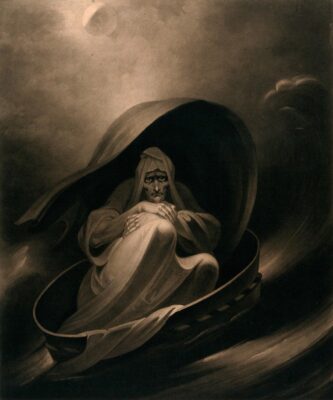Divination by the sieve and shears, or coscinomancy, dates back to ancient Greece. In the early modern period it was most commonly practised by those in the middling and lower social ranks, typically to identify thieves. Courts heard numerous cases like that of the 1641 labourer’s wife from Lancashire who used the sieve and shears to find out who had stolen a sheep and hen, and whether two local women were pregnant.1Deborah Lea, ‘Witchcraft, Possession and Confessional Tension in Early Modern Lancashire’ (University of Liverpool PhD thesis, 2011), p. 60. The practice was described by John Aubrey in 1686 as follows: ‘The shears are stuck in a sieve, and two maidens hold up the sieve with the top of their fingers by the handle of the shears: then say, “by St Peter and St Paul such a one hath stolen (such a thing),” the others say, “By St Peter and St Paul he hath not stolen it.” After many such adjurations, the sieve will turn at the name of the thief.’2John Aubrey, Remaines of Gentilisme and Judaisme, ed. James Britten (London, 1881 [1686-7]), p. 25.
In 1595, the Welsh author Robert Holland referenced the divinatory use of a sieve with a rod or knitting needles.3‘Gwagr ac a gwelle.’ Robert Holland, Tvdyr ag Ronw (1595), in Rhys Prichard, Canwyll y Cymry, ed. Stephen Hughes (London, 1681), p. 464. Other authors suggested that the sieve might be suspended by a piece of thread.4For example, John Potter, Archaeologiæ Græcæ, 2 vols (Oxford, 1699), vol. 1, p. 320. Instead of the reference to Peter and Paul, sometimes a chapter of the Bible was read, or a Latin phrase. Cornelius Agrippa (1486-1535) theorised that the incantation summoned a demon who caused the sieve to turn.5Cornelius Agrippa, De Occulta Philosophia (1567) in Opera Omnia (Lyon, 1600), ch. 21, p. 472. A more charitable interpretation was that God was offering his assistance. The 17th-century clergyman Thomas Gataker suggested another possibility: if one of the practitioners suspected the thief’s identity, they might unconsciously move their hand when her or his name was read out, causing the sieve to turn.6Thomas Gataker, Of the Nature and Use of Lots (London, 1619), p. 348.

Mezzotint of a witch surfing on a sieve, 1807.7Charles Turner, mezzotint (1807) after John James Halls (active 1791-1834), Wellcome Collection.

A 1579 portrait of Elizabeth I with a sieve. In this case, the sieve was not for divinatory purposes, but to symbolise Elizabeth’s purity through allusion to Tuccia, the ancient Roman Vestal Virgin who proved her chastity by carrying water in a sieve.8George Gower, Plimpton Sieve Portrait of Queen Elizabeth I (1579), Wikimedia Commons.
Criticism of the sieve and shears published in 1711 by the Welsh author T. P.9T. P., Cas Gan Gythraul, ed. and trans. Lisa Tallis (Newport, 2015 [1711]), p. 101.
There are others who usually take a sieve and shears to divine by. One told me that she witnessed this form of divination regarding a pair of gloves that were lost. The sieve and shears concerned were held up, so that there was one either side of it supporting it on their hands, and they were reciting some words from the Holy Scripture and saying that, in the name of St. Paul and that of St. Peter, they were praying for the sieve to turn if they named such a person who had taken the gloves. And the person who witnessed this wicked custom being performed, told me that she saw the sieve turning. Besides, after they discovered the mystery of who took the gloves, they again took the sieve and shears in hand to discover where in the house of such a one who stole them they were kept. But the sieve did not move until they named the chest, at which point the sieve began to turn. After that they demanded a warrant, and went to search and found the gloves in the chest of the woman whose name caused the sieve and shears to turn. Better that they had lost the gloves, than risk losing their souls by keeping counsel with the Devil because of them.
Think of a question with multiple possible answers. Play the video and recite the answers (in a loop if necessary). Note which answer you are saying at the point when the sieve stops turning!10We have adapted this practice. Early modern authors describe looking at when the sieve started turning, not when it stopped. We struggled to replicate this; depending on how our sieve was affixed to the shears it either turned immediately or refused to turn at all…
In 1702, the church in Minnigaff, Galloway, investigated a case of divination by sieve and shears.11National Records of Scotland, kirk session records of Minnigaff, Galloway, 1702, CH2/1404/1, pp. 29-30.
There being a flagrant report that some persons in this parish … should have practised that piece of devilry commonly called turning the riddle … Marion Murray unmarried aged eighteen years or thereby … deponed that she (not having seen any other person do it before her) together with the nurse held the riddle betwixt them, having a pair of little scissors fastened into the rim of the riddle whereof the nurse Mally Redmond had one [handle] and she the other, and that the nurse mumbled some words mentioning Peter and Paul, and that when the nurse said these words the riddle stirred less or more.

Illustration of the sieve and shears in a 1567 work by Cornelius Agrippa.12Cornelius Agrippa, De Occulta Philosophia (1567) in Opera Omnia (Lyon, 1600), ch. 21, p. 472, Google Books.
In 1554, William Hasylwoode was accused of employing the sieve and shears to find his lost purse.13William Hale, A Series of Precedents and Proceedings in Criminal Causes: Extending from the Year 1475 to 1640 (London, 1847), p. 139.
…in July … having then lost his purse with 14 groats [4 shillings and 8 pence] … and thereupon remembering that he being a child did hear his mother declare that when any man had lost any thing then they would use a sieve and a pair of shears to bring to knowledge who had the thing lost … did take a sieve and a pair of shears and hanged the sieve by the point of the shears and said these words: “by Peter and Paul he hath that,” naming the party whom he in that behalf suspected, which thing he never used but once…
